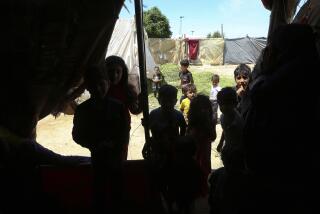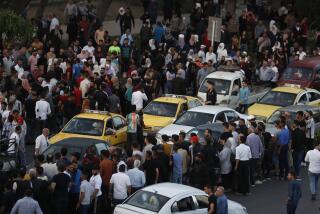Syria’s fault lines
Syria has long had a diverse population that managed to live together in relative harmony. And the struggle to end Baathist rule drew together citizens from across class, economic, religious and ethnic lines. But now, in the fog of war, a growing sectarianism suggests that a stable Syria after President Bashar Assad’s eventual ouster may prove to be elusive.
Unfortunately, some at the forefront of the 17-month-long conflict are no longer championing inclusiveness as they did when the uprising began. “We ate from the same plate and then they stabbed us in the back,” lament Syrian Christians.
That critique is applicable not only to Assad loyalists who are fanning the flames of faith and background to hold on to faltering supporters but also to Assad’s opponents, who are blaming minorities for supposedly having bolstered the regime for decades.
The Arab Spring, like the Iranian Revolution and the Iraq war (and subsequent civil war) before it, suggests that new political systems that are tolerant and representative of entire populations prove hard to establish. Indeed, the emergent violence against religious minorities in Syria is becoming yet another instance of how Middle Eastern countries that replace dictators still fail their citizens.
Syria’s population of 22.5 million is made up of a diverse citizenry: 70% to 74% Sunnis; 13% Alawites and other Shiites, including Ismailis; 10% Christians such as Greek Orthodox, Syrian Orthodox and Church of the East (i.e., Assyrians), Armenian Apostolic, Eastern rite Catholics, including Chaldeans and Melkites; 3% Druze; and even small yet vibrant Jewish and Yazidi communities. By ethnicity, Syrian society is 90% Arab, with the remaining 10% made up of Kurds, Assyrians, Armenians and others.
Since the uprising against Assad’s regime, an estimated 120,000 refugees have taken shelter in Turkey, Lebanon, Jordan and Iraq, and their numbers are growing, according to the United Nations. The Syrian Arab Red Crescent estimates that 1 million citizens are internally displaced and in need of food, shelter and medical care. In addition, the U.N. estimates that more than 17,000 people — including noncombatants — have died.
Although the Syrian civil war has claimed casualties from all groups, those subject to displacement and persecution are, increasingly, members of minority groups. In Damascus, Aleppo, Hama, Homs and Qusair, people of different faiths and ethnicities lived in shared neighborhoods or in proximate areas for centuries, even during nearly five decades of Baathist rule. That harmony is fraying now, replaced by claims of long-held hatreds.
Domestic and foreign Sunni militants and local clerics even use the loudspeakers of mosques — customarily employed for the call to prayer — to order Druze, Christians and Shiites to leave the area or face danger and possibly death at the hands of their former co-denizens. Women are being targeted in tit-for-tat kidnappings and rapes as violence rises between their communities.
The growing role of Al Qaeda brigades lends urgency to the need to deal with the deteriorating conditions for groups not affiliated with Syria’s majority Sunnis. These Al Qaeda terrorists, crossing over from Sunni strongholds in Iraq and increasingly independent of indigenous anti-Assad forces like the Free Syrian Army, target those they believe to be regime supporters largely on the basis of religious affiliation.
Druze, who are denounced by fundamentalist Sunnis as spiritual cousins of the Alawites — the minority group that the Assad clan belongs to, which is seen as backed by Iran — and Christians, who are blamed for working in the Syrian armed forces, bear the brunt of attacks. There are Assyrians and other minorities who opposed the Assad government for more than a decade even at the expense of alienating others within their communities who saw safety coming from, ironically, political repression. But that carries little value among Sunni militants, who hold both weapons and cash.
The extremists who seek to eradicate diversity could bring about the elimination of Alawites, Christians, Druze and Yazidis from a country where their history is long and deep. Indeed, ongoing events in Syria may come to parallel those in post-Saddam Hussein Iraq, where sectarian strife devastated the Mandaean community and reduced the Christian population by two-thirds.
Yet the outcome in Syria need not be one of sectarian fracture. Most Syrians do not support or engage in violence along religious and ethnic lines. Leaders of the Free Syrian Army and other indigenous opposition groups have attempted to keep sectarianism at bay, knowing it is detrimental to their cause. Their efforts need to be bolstered from the outside.
The United States and the European Union should make their political and fiscal assistance to the rebel groups conditional on respect for human rights and religious freedom. Likewise, the United Nations must insist that the legitimate rights recognized by international charters and conventions be protected. The Free Syrian Army and other indigenous rebel groups, if held firmly by the international community to support rights, can turn the tide against Sunni militants and other intolerant factions, thereby ensuring that a post-Assad Syrian society is a multiethnic and multireligious one.
After all, any resolution of the Syrian civil war that lacks attention to overcoming ethnic and religious divides will have long-term consequences not just for that nation but for the entire region.
Eden Naby, a cultural historian of the Middle East who has taught at the University of Wisconsin and Harvard University, is author of “Assyrians of the Middle East” (2013). Jamsheed K. Choksy is a professor of Central Eurasian, Islamic and international studies at Indiana University.
More to Read
A cure for the common opinion
Get thought-provoking perspectives with our weekly newsletter.
You may occasionally receive promotional content from the Los Angeles Times.










